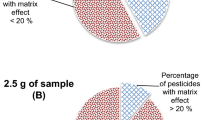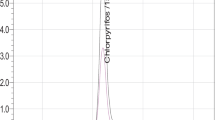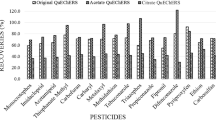Abstract
Acetate- and citrate-buffered quick, easy, cheap, effective, rugged, safe (QuEChERS) pretreatment methods were evaluated for the determination of various pesticides in peaches, grapes, apples, bananas, pears, and strawberries from various regions of Greece, using LC-MS/MS. The purposes of this study were (i) to evaluate which type of QuEChERS method was the most appropriate and effective for each matrix; (ii) to apply the selected QuEChERS method for each matrix, in order to detect and quantify pesticide residues in various fruit samples using UPLC-MS/MS; (iii) to examine the concentration distribution of pesticide classes among fruit originating from various areas; and (iv) to assess pesticide concentration distribution between peel and flesh of fruit in order to evaluate the penetration of pesticide residues in the fruit flesh. Acetate-buffered QuEChERS was found to be the most suitable technique for most of the fruit matrices. According to the recovery values at two different concentration levels, peaches should preferably be treated by the citrate-buffered type, whereas grapes, bananas, apples, pears, and strawberries are best treated by the acetate-buffered version, although the differences in efficiency were small. The addition of graphitized carbon black significantly decreases the recovery of specific pesticides in all matrices except for strawberries. The majority of values do not exceed the official maximum residue levels set by the European Commission. Organophosphates proved to be the most commonly detected category along with triazines-triazoles-conazoles group and by carbamates. Apples and pears seem to be the most contaminated fruit matrices among those tested. Distribution of pesticide classes shows variations between different regions, suggesting different pesticide application practices. In the case of peaches and pears, there is an equal distribution of detected pesticides between peel and flesh, indicating penetration of contaminants into the fruit flesh.





Similar content being viewed by others
References
Akiyama Y, Matsuoka T, Yoshioka N, Akamatsu S, Mitsuhashi T (2011) Pesticide residues in domestic agricultural products monitored in Hyogo Prefecture, Japan. J Pest Sci 36:66–72
Anastassiades M, Lehotay SJ, Štajnbaher D, Schenck FJ (2003) Fast and easy multiresidue method employing acetonitrile extraction/partitioning and “dispersive solid-phase extraction” for the determination of pesticide residues in produce. J AOAC Int 86(2):412–431
Andraščíková M, Hrouzková S, Cunha SC (2013) Combination of QuEChERS and DLLME for GC-MS determination of pesticide residues in orange samples. Food Add Contam 30:286–297
Bakirci GT, Acay DBY, Bakirci F, Ötleş S (2014) Pesticide residues in fruits and vegetables from the Aegean region. Turkey Food Chemistry 160:379–392
Cervera MI, Portolés T, López FJ, Beltrán J, Hernández F (2014) Screening and quantification of pesticide residues in fruits and vegetables making use of gas chromatography-quadrupole time-of-flight mass spectrometry with atmospheric pressure chemical ionization. Anal Bioanal Chem 406:6843–6855
Commission Decision 2002/657/EC, Commission decision of August 2002 implementing Council Directive 96/23/EC concerning the performance of analytical methods and the interpretation of results
Commission Decision 2007/442/EC COMMISSION DECISION of 21 June 2007 concerning the non-inclusion of certain active substances in Annex I to Council Directive 91/414/EEC and the withdrawal of authorizations for plant protection products containing these substances, Official Journal of the European Union, L 166/16, 28.06.2007
Costa FP, Caldas SS, Primel EG (2014) Comparison of QuEChERS sample preparation methods for the analysis of pesticide residues in canned and fresh peach. Food Chemistry 165:587–593
España Amórtegui JC, Guerrero Dallos JA (2014) Comparison of QuEChERS official methodologies for the analysis of pesticide residues on Colombian fruit by GC-MS. Food Addit Contam A 31:676–687
Farré M, Picó Y, Barceló D (2014) Application of ultra-high pressure liquid chromatography linear ion-trap orbitap to qualitative and quantitative assessment of pesticide residues. J Chrom A 1328:66–79
Fenoll J, Hellín P, Martinez MC, Flores P (2010) Multiresidue analysis of pesticides in vegetables and citrus fruits by LC-MS/MS. Chromatographia 72:857–866
Ferrer C, Martínez-Bueno MJ, Lozano A, Fernádez-Alba AR (2011) Pesticide residue analysis of fruit juices by LC-MS/MS direct injection. One year pilot survey. Talanta 83:1552–1561
Gómez-Ramos MM, Ferrer C, Malato O, Agüera A, Fernández-Alba AR (2013) Liquid chromatography-high resolution mass spectrometry for pesticide residue analysis in fruit and vegetables: screening and quantitative studies. J Chrom A 1287:24–37
Hercegová A, Dömötörová M, Kružlicová D, Matisová E (2006) Comparison of sample preparation methods combined with fast gas chromatography-mass spectrometry for ultratrace analysis of pesticide residues in baby food. J Sep Sci 29:1102–1109
Lacassie E, Dreyfuss M, Daguet JL, Vignaud M, Marquet P, Lachâtre G (1999) Liquid chromatography–electrospray mass spectrometry multi-residue determination of pesticides in apples and pears. J Chrom A 830:135–143
Lehotay SJ, Son KA, Kwon H, Koesukwiwata U, Fud W (2010) Comparison of QuEChERS sample preparation methods for the analysis of pesticide residues in fruits and vegetables. J Chrom A 1217:2548–2560
Lozowicka B (2015) Health risk for children and adults consuming apples with pesticide residue. Sci Total Environ 502:184–198
PMEP (Pesticide Management Education Program, Cornell University) (1993) http://pmep.cce.cornell.edu/profiles/extoxnet/dienochlor-glyphosate/disulfoton-ext.html
Moreno JLF, Frenich P, Bolaños P, Vidal JLM (2008) Multiresidue method for the analysis of more than 140 pesticide residues in fruits and vegetables by gas chromatography coupled to triple quadrupole mass spectrometry. J Mass Spec 43:1235–1254
Neicheva A, Kovacheva E, Marudov G (1988) Determination of organophosphorus pesticides in apples and water by gas-liquid chromatography with electron-capture detection. J Chrom A 437:249–253
Regulation EC 396/2005: EU Pesticides database MRLs Regulation (update 18/04/2014) (ec.europa.eu/sanco_pesticides/public)
SANCO/12571/2013 Guidance document on analytical quality control and validation procedures for pesticide residues analysis in food and feed. EC, Health & Consumer Protection Directorate General.
Turgut C, Ornek H, Cutright JT (2010) Pesticides residues in dried table grapes from the Aegaen region of Turkey. Environ Monit Assess 167:143–149
Turgut C, Ornek H, Cutright JT (2011) Determination of pesticide residues in Turkey’s table grapes: the effect of integrated pest management, organic farming and conventional farming. Environ Monit Assess 173:315–323
USEPA (1998) R.E.D. Facts, Propachlor, EPA-738-F-98-013
USEPA 2007a Reregistration Eligibility Decisions for Dimethoate, 2007, US Environmental Protection Agency Office of Pesticide Programs
USEPA 2007b Reregistration Eligibility Decision for Carbofuran, 2007, US Environmental Protection Agency Office of Pesticide Programs
Wang S, Xu Y, Pan C, Jiang S, Liu F (2007) Application of matrix solid-phase dispersion and liquid chromatography–mass spectrometry to fungicide residue analysis in fruits and vegetables. Anal Bioanal Chem 387:673–685
Wang J, Chow W, Leung D, Chang J (2012) Application of ultrahigh-performance liquid chromatography and electrospray ionization quadrupole orbitrap high-resolution mass spectrometry for determination of 166 pesticides in fruits and vegetables. J Agric Food Chem 60:12088–12104
Waters Co (2008) Application note Library Number: APNT10069469—a rapid method for the screening and confirmation of over 400 pesticide residues in food: http://www.waters.com/waters/library.htm?cid=511436&lid=10069469&locale=en_GR#sthash.SKpoUL0s.dpuf(http://www.waters.com/waters/library.htm?cid=511436&lid=10069469&locale=en_GR#sthash.SKpoUL0s.dpuf))
Zrostlíková J, Hajšlová J, Kovalczuk T, Štěpán R, Poustka J (2003) Determination of seventeen polar/thermolabile pesticides in apples and apricots by liquid chromatography/mass spectrometry. J AOAC Int 86:612–622
Acknowledgments
The authors would like to thank the “Stavros Niarchos Foundation” for funding the acquisition of the Acquity UPLC-MS/MS instrument, by which this research was made possible.
Author information
Authors and Affiliations
Corresponding author
Additional information
Responsible editor: Ester Heath
Electronic supplementary material
Below is the link to the electronic supplementary material.
ESM 1
(DOCX 75 kb)
ESM 2
(DOCX 18 kb)
ESM 3
(DOCX 19 kb)
ESM 4
(DOCX 21 kb)
ESM 5
(DOCX 21 kb)
ESM 6
(DOCX 22 kb)
ESM 7
(DOCX 22 kb)
ESM 8
(DOCX 21 kb)
ESM 9
(DOCX 21 kb)
ESM 10
(DOCX 21 kb)
ESM 11
(DOCX 21 kb)
ESM 12
(DOCX 21 kb)
ESM 13
(DOCX 21 kb)
ESM 14
(DOCX 21 kb)
ESM 15
(DOCX 21 kb)
ESM 16
(DOCX 24 kb)
ESM 17
(DOCX 23 kb)
ESM 18
(DOCX 21 kb)
ESM 19
(DOCX 40 kb)
ESM 20
(DOCX 24 kb)
ESM 21
(DOCX 21 kb)
ESM 22
(DOCX 18 kb)
ESM 23
(DOCX 48 kb)
ESM 24
(DOCX 48 kb)
ESM 25
(DOCX 43 kb)
ESM 26
(DOCX 41 kb)
ESM 27
(DOCX 36 kb)
Rights and permissions
About this article
Cite this article
Christia, C., Bizani, E., Christophoridis, C. et al. Pesticide residues in fruit samples: comparison of different QuEChERS methods using liquid chromatography–tandem mass spectrometry. Environ Sci Pollut Res 22, 13167–13178 (2015). https://doi.org/10.1007/s11356-015-4456-0
Received:
Accepted:
Published:
Issue Date:
DOI: https://doi.org/10.1007/s11356-015-4456-0




